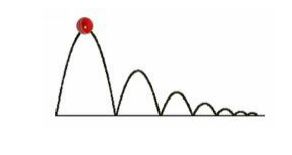Shortcut -Arithmetic Progression
Finding nth term of an Arithmetic Progression.
$t_{n}$=a+(n-1)d
Parameters:
a - first term of the series.
d - common difference between successive terms. a2 – a1
n - the number position of the term.
$t_{n} $ - the term that has to found out.
Question:
What is the 100th term of the series?
1. 2, 7, 12, 17, 22, …
2. 501, 497, 493, 489, 485, …
1. a = 2;
d = 5;
n = 100
$t_{n}= 2 + (100 – 1)5$
$t_{n} = 2 + 495 = 497$
$t_{100}= 497$
2. a = 501;
d = - 4;
n = 100
$t_{n} = 501 + (100 – 1)(- 4)$
$t_{n} = 105$
$t_{100} = 105$
Shortcut -Arithmetic Progression
Number of terms in an Arithmetic Progression.
$n=\dfrac{(l-a)}{d}+1$
l- Last term of the series.
Question:
Find the number of terms in the series:
1. 2, 7, 12, 17, 22, … 382
2. 501, 497, 493, 489, 485, … 201
1. n= $\dfrac{(382-2)}{5}+1$
n = 77
2. n=$\dfrac{(201-501)}{-4}+1$
n = 76
Shortcut -Arithmetic Progression
Sum of the terms in an Arithmetic Progression.
$S_{n}=(a+1)\dfrac{n}{2}$
l - Last term of the arithmetic series.
Question:
Find the sum of the series:
1. 2, 7, 12, 17, 22, … 497
2. 501, 497, 493, 489, 485, … 105
1. Number of terms, $n = \dfrac{(497-2)}{5} +1$
n = 100
Sum = (2 + 497)(100/2)
S = 24950
3. Number of terms, $n =\dfrac{(105-501)}{-4}+1$
n = 100
Sum = (501 + 105)(100/2)
S = 30300
Shortcut -Geometric Progression
Finding nth term of a Geometric Progression.
$t_{n}=ar^{n-1}$
$t_{n} $ - nth term.
a - first term of the series.
r - common ratio between the successive terms. (a2/a1)
n - number position of the term in the series.
Question:
Find 8th term of the series 3, 6, 12, …
Answer: n = 8;
a = 3;
r = (6/3) = 2
8-1
$t_{8}= 3(2)$
$t_{8} = 3(128)$ = 384
Question:
Find 6th term of the series 400, 200, 100, …
Answer: n = 6; a = 400; r = (200/400) = 01/2
$t_{6} = 400(1/2)^{6-1}$
$t_{6}= 400(1/32) = 12.5$
Shortcut -Geometric Progression
Sum of the terms of a finite series where r > 1.
$S_{n}=\dfrac{a(r^{n}-1)}{r-1}$
$S_{n}$ - Sum of n terms of the series.
Question:
Find the sum of the series 3, 6, 12, 24, … up to 10 terms.
Answer: a =3
n = 10
r = (6/3) = 2; here r > 1.
$S_{n} =\dfrac{3(2^{10}-1)}{2-1}= 3069$
Question:
Find the sum of the series 10, 30, 90, 270, … up to 8 terms.
Answer: a = 10
n =8
r = (30/10) = 3;
here r > 1.
$S_{n} =\dfrac{10(3^{8}-1}{3-1} $= 32800
Shortcut -Geometric Progression
Sum of the terms of a finite series where r < 1.
$S_{n}=\dfrac{a(1-r^{n}}{1-r}$
Question:
Find the sum of the series 600, 300, 150, … up to 6 terms.
Answer: a = 600
n=6
r = (300/600) = 1/2; here r < 1
$S_{n} = \dfrac{600(1-\dfrac{1}{2}^{6}}{1-\dfrac{1}{2}} $= 1181.25
Question:
Find the sum of the series 128, 64, 32, … up to 10 terms.
Answer: a = 128;
n = 10;
r = 64/128 = ½ (r < 1)
$S_{n}= \dfrac{128(1-\dfrac{1}{2}^{10}}{1-\dfrac{1}{2}} $ = 255.75
Shortcut -Geometric Progression
Sum of the terms of an infinite series where r < 1.
$S_{n}=\dfrac{a}{1-r}$
Question:
A ball is thrown up in the air for 400 m. every time the ball hits the ground it will bounce back one third of the height it went the last time. The ball repeats this bounce as long as it rests in the ground. What is the total distance covered by the ball?
 Answer:
Answer: Distance travelled in the first throw = 450 + 450 = 900.
(450 + 450 is because the total distance is both up and down distance covered).
Distance covered in the first bounce = (1/3)900 = 300
Distance covered in second bounce = (1/3)300 = 100
The series is 900, 300, 100, … infinite terms.
Sum = 900/[1 – (1/3)]
Sum = 1350 m
